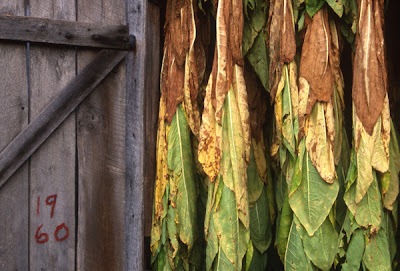Well, let's get smokin', 'tis the season to cut tobacco and "house" it in a barn! I am sharing some additional photos today of this crop which was formerly grown by many small farmers where I live in northeastern Kentucky and is now grown only by a few. I will try to put this week's set in more or less chronological order.
 |
| truck bed with flats holding plants now big enough to be put in the ground (see last week's post for a photo of tobacco being planted) |
 |
| newly planted tobacco in Donnie's field, a photo whose title is "earthbound book" |
 |
| This tobacco is overdue to be "topped" and de-suckered....sticky, hot, hard work, with bees for company |
 |
| I don't usually see tobacco blooms this far along, and, not having to work it, I thought it lovely. |
 |
| The yellowing means the tobacco is getting ready to be cut and housed, usually in late August or September. |
 |
| The earthbound book field, in September, with some of the rows cut, the plants left a day or two in the field to dry out a bit before all that lifting to come |
 |
| unloading the trailer and hanging the sticks holding the plants |
 | ||
| hanging to cure (barn built in 1960?) The plants hang like possums for a couple of months, depending on the weather, and then the leaves are stripped off the stalks. |
 |
| a favorite photo of mine, see my post #7 -- Sandy, Junie and Dorsie stripping their last ever crop of tobacco, two years ago |


No comments:
Post a Comment